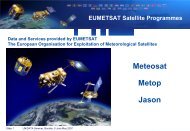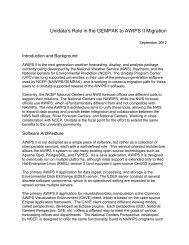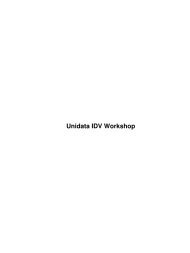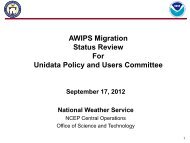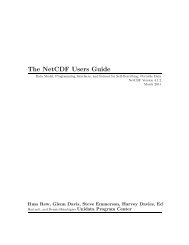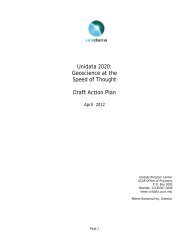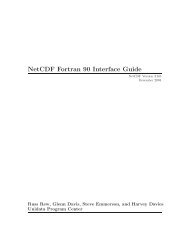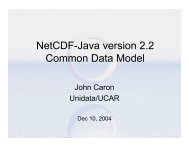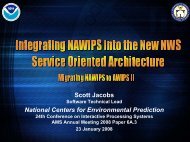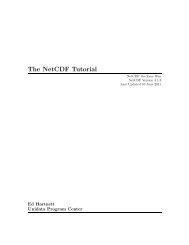Junhong (June)Wang - Unidata
Junhong (June)Wang - Unidata
Junhong (June)Wang - Unidata
Create successful ePaper yourself
Turn your PDF publications into a flip-book with our unique Google optimized e-Paper software.
Atmospheric Sounding:<br />
Basics, Research and Development<br />
Radiosonde, Dropsonde and Driftsonde<br />
<strong>Junhong</strong> (<strong>June</strong>) <strong>Wang</strong><br />
NCAR Earth Observing Laboratory<br />
Courtesy of EOL sounding<br />
group: Terry Hock, Hal Cole,<br />
Kate Young, Dean Lauritsen,<br />
Scot Loehrer and others
1. Radiosonde<br />
• Overview<br />
• History<br />
• Sensors<br />
Outline:<br />
• Future (sensor, network, other applications)<br />
2. Dropsonde<br />
3. Driftsonde<br />
4. Questions, comments and feedback
Radiosonde Overview<br />
(1) To make accurate measurements of<br />
important atmospheric parameters (usually<br />
temperature, pressure, humidity and wind)<br />
above the surface<br />
(2) To send this information back in as<br />
close to real-time as possible<br />
Receiving<br />
equipment<br />
From Dabberdt et al. (2002)
Radiosonde Applications: Operation and Field projects<br />
•Input for weather prediction<br />
models;<br />
•Local severe storm, aviation, and<br />
marine forecasts;<br />
•Climate change research;<br />
•Input for air pollution models;<br />
•Ground truth for satellite data;<br />
•Characterization of thermodynamical<br />
and wind profiles<br />
CCSP (2006)<br />
http://www.eol.ucar.edu/homes/junhong/Ency-radiosonde.pdf
Other special radiosondes<br />
Ozonesonde:<br />
ozone profiles<br />
Radioactivity sonde:<br />
Β and γ radioactivity<br />
Needs:<br />
1. Trace gases<br />
2. Vertical velocity<br />
3. Turbulence<br />
4. Radiation profiles<br />
Electricity:<br />
ctric field probe<br />
Harrison<br />
and Hogan<br />
(2006)<br />
In-cloud measurements:<br />
changes in charge, aerosols<br />
http://www.eol.ucar.edu/homes/junhong/MT11B_radiosondes.pdf
Global radiosonde network<br />
(WMO report, July 2007)<br />
~917 stations<br />
~15 types<br />
00 and 12 UTC at 2/3 stations<br />
Vaisala: 51% (35% in 1993)<br />
VIZ (Sippican): 9%
Current and future radiosondes in U.S.A.<br />
VIZ B-2<br />
(32)<br />
Intermet<br />
Sippican<br />
Mark IIA<br />
Microsonde<br />
Vaisala<br />
RS80-H<br />
(60)<br />
Courtesy of Joe Facundo (NWS/NOAA)
History of radiosondes<br />
• 18 th and 19 th centuries:<br />
1. A kite with a thermometer in 1749 in Glasgow, Scotland<br />
2. Manned hot air and hydrogen balloons in 1800’s • 3-5 km<br />
3. Kite observation network in U.S. by the end of the 1800’s<br />
• data loss<br />
• Early 1900’s:<br />
1. Meteorograph carried by free, unmanned balloons • good weather<br />
2. Aircraft sounding in 1925-1940s<br />
3. Pilot balloon tracked by optical theodolite<br />
• 1930’s-1950’s:<br />
1. The first radio-meteorographs (“radiosondes”) in the early 1930’s<br />
2. 1937: the U.S. NWS radiosonde network<br />
3. Automated radio-theodolites (“rawinsonde”) by the 1950s<br />
• 1960’s – 1980’s:<br />
1. Computerized reduction of rawinsonde data (automation)<br />
2. Radio-navigation aids (NAVAID): LORAN and Omega for wind<br />
• 1990’s:<br />
1. Improved sensors, data processing and NAVAID system<br />
2. GPS for wind measurements
Handbook of Meteorological<br />
Instruments, HMSO, 1961<br />
Kite-carried sensors<br />
Dines’ Kite Meteorograph
Meteorological Observatory Lindenberg – Richard-Aßmann-Observatory<br />
Measurements 1905-1932 at Aeronautical<br />
Observatory Lindenberg<br />
World Record<br />
kites & balloons<br />
May 2006<br />
Franz H. Berger
Continuous Evolution of Vaisala Radiosondes<br />
1931<br />
RS11<br />
1983<br />
RS80<br />
1997<br />
RS90<br />
2003<br />
RS90<br />
RS80H<br />
Vaisala RS92<br />
•Code-correlating GPS<br />
•Digital transmission<br />
•Twin Humicaps<br />
•New ground check set<br />
•Smaller/faster T sensor<br />
AKP Sept2003
CLASS-LORAN LORAN based, 10<br />
second data, species<br />
extinct in ‘98<br />
GLASS–1st generation GPS<br />
winds, used RS-80<br />
Radiosonde, extinct in ‘05<br />
GAUS- RS92SGP<br />
radiosonde compatible,<br />
all digital radiosonde<br />
Courtesy of Tim Lim
Temperature sensors:<br />
1. Thermistor<br />
2. Thermocapacitor<br />
3. Wire resistor<br />
4. Thermocouple<br />
5. Bimetallic<br />
Vaisala<br />
aluminized capacitance<br />
Sippican chip thermistor<br />
Meisei bead ther.<br />
Modem bead<br />
Graw bead<br />
SRS<br />
thermocouple<br />
Nash et al. (2006)
Temperature bias at 10 hPa<br />
for six WMO radiosonde intercomparisons
Future: Radiation errors<br />
Luers (1990)<br />
mC(dT/dt) = q abs –q emit + q conv + q elec + q cond<br />
Option #1: Multi-thermistor Technology<br />
• Simultaneously solving multiple heat balance equations;<br />
• Each with different emissivity and absorptivity values;<br />
• Conduction and thermal lag error correction are included;<br />
• Knowledge of the environmental radiative background is not<br />
necessary.<br />
Optional #2: Better radiation corrections<br />
• Radiation sensors on the sonde<br />
• Calculating radiation flux profiles with observed cloud, aerosol and<br />
other parameters
Humidity sensors:<br />
1. Thin-film capacitor<br />
2. Carbon hygristor<br />
3. Goldbeater’s skin<br />
4. Dew/frost-point<br />
hygrometer<br />
5. Tunable diode<br />
laser (TDL)<br />
Carbon<br />
hygristor<br />
Vaisala Humicap<br />
Modem<br />
capacitive<br />
Meisei<br />
capacitive<br />
Goldbeater’s<br />
skin<br />
Graw<br />
capacitive
Current status on water vapor<br />
Stratosphere:<br />
• No current operational<br />
radiosonde can provide<br />
humidity measurements in ST.<br />
• Should we continue to ignore<br />
the ST?<br />
Update to<br />
Oltmans et al., GRL 2001<br />
from Holger Voemel<br />
Troposphere:<br />
• Various problems still exist.<br />
• Corrections are needed, but<br />
not effective in UT.
WAVES 2006<br />
Howard University<br />
Beltsville, MD<br />
From Holger Voemel
Future: Homogenization global radiosonde humidity data<br />
RH anomaly at 500mb<br />
25<br />
20<br />
15<br />
10<br />
5<br />
0<br />
-5<br />
-10<br />
-15<br />
-20<br />
-25<br />
Astor<br />
Mark I<br />
False change<br />
Philips<br />
MK II<br />
Townsville<br />
Philips<br />
MK II+half<br />
Philips MK III<br />
Real change<br />
Vaisala RS80<br />
76 78 80 82 84 86 88 90 92 94 96<br />
Years<br />
Lithium Cloride Carbon<br />
HUMICAP<br />
hygristor<br />
<strong>Wang</strong> et al. (2001)
Future: GCOS Reference Upper Network<br />
Seidel et al. (2009, BAMS)<br />
• Provide long-term, high-quality climate records<br />
• Constrain/calibrate data from more spatially-comprehensive global<br />
observing systems<br />
AGU Chapman Conference on Atmospheric Water Vapor and its Role in Climate Program, Kailua-Kona, Kona, Hawaii, 20-24<br />
24<br />
October • Measure 2008<br />
large suite of co-related climate variables
Future: Other parameters -- rise rate calculation<br />
Buoyancy force = Drag force<br />
[BV*ρ s -(m s + m b + m h )]*g g = C D *A*ρ*V<br />
*V 2 f /2<br />
Buoyancy<br />
m h = BV * ρ *4.0026/28.9644<br />
V f = (2*BF/ C D *A*ρ) 1/2<br />
Drag<br />
Dabberdt et al. (2002)<br />
<strong>Wang</strong> et al. (2009)<br />
BV: ~20-40 ft 3 ?<br />
m s = 330g m b =200g<br />
C D ~ 0.4 ?<br />
A = 4*π *[3*BV/(4*π)] 2/3<br />
ρ: density (kg m -3 )<br />
Vertical Wind = V measured - V f
T-REX (Terrain-induced Rotors Experiment) in 2006:<br />
Radiosonde Detected Downdrafts<br />
3/26/06 0312 UTC 6000<br />
Relative Humidity (%) Wind Speed (m/s)<br />
0 30 60 0 20 40 60<br />
8000<br />
8000<br />
6000<br />
UTC Launch Time:<br />
2006 03 26 03:12<br />
Track<br />
8<br />
6<br />
Altitude (m)<br />
4000<br />
4000<br />
4<br />
Elevation (km)<br />
2000<br />
W U T<br />
0<br />
-20 -10 0 10 -40 20 -20 0 20<br />
Vertical Velocity (m/s) Air Temperature (C)<br />
2000<br />
Terrain<br />
0<br />
0<br />
-118.2 -117.9 -117.6 -117.3<br />
Longitude<br />
2
GAUS in Owens Valley<br />
T-REX GAUS-ISS (Mar. 2006; Soundings 1-30)<br />
Gravity Waves<br />
Rotors<br />
Larger rise rate and larger variability<br />
Turbulence???
•<br />
: track Mountain waves<br />
Dropsonde 20060416 22:24:37 to 20060417 02:13:34 (36.23N-36.48N)<br />
Altitude (km)<br />
8<br />
7<br />
6<br />
5<br />
4<br />
3<br />
2<br />
I II III IV<br />
Dropsonde<br />
12<br />
8<br />
5<br />
2<br />
1<br />
0<br />
-1<br />
-2<br />
-5<br />
-8<br />
-12<br />
1<br />
-118.5 -118.4 -118.3 -118.2 -118.1 -118.0 -117.9<br />
Longitude<br />
AVAPS User’s s Workshop, Boulder, CO, 22-23 23 February 2008
NCAR GPS Dropsonde<br />
Currently on 21 research aircraft<br />
Licensee (Vaisala) makes ~ 5,000 per year
MLLJ on <strong>June</strong> 9 during IHOP<br />
1. Box flight path (clockwise)<br />
2. Clear sky in the domain<br />
3. LLJ on the northern leg<br />
4. Lear: 48 (took off from<br />
NW corner, ~50 km, two<br />
box flights)<br />
5. Falcon: 21 (took off from<br />
SE corner, ~50 km)<br />
6. Mapping moisture and<br />
intercomparison with<br />
DIAL, LASE, NAST
T/RH variations for two Lear box flights <strong>June</strong> 9<br />
RF9<br />
RF10
Dropsonde into Hurricanes
Thanks to<br />
James Franklin,<br />
NOAA/AOML/NHC<br />
Data courtesy<br />
Sim Aberson, HRD
UKMET MODEL<br />
WITHOUT SONDES<br />
WITH SONDES<br />
James Franklin<br />
Courtesy Julian Heming, UKMO
DRIFTSONDE Concept<br />
Zero or Super Pressure<br />
Balloon (363 m 3 )<br />
Iridium LEO Satellite<br />
Communications<br />
Gondola<br />
20-50 Sonde<br />
Capacity<br />
Flight Altitude<br />
125mb to 50mb (~58,000’)<br />
Dropsonde<br />
PTH &Wind<br />
Sondes Dropped<br />
by Time or Command<br />
Command & Control<br />
Ground Station<br />
Cost-effective dropsonde observations of wind, temperature, and<br />
North<br />
humidity to fill critical gaps 57 th Interdepartmental Hurricane<br />
Atlantic in coverage<br />
Conference<br />
Ocean<br />
over oceanic<br />
Europe<br />
and remote artic<br />
America<br />
and continental regions over days to weeks.
Miniature In-situ Sounding Technology<br />
(MIST Sonde)<br />
MIST Sonde<br />
•Small size<br />
•Lightweight (184 g)<br />
•Low cost<br />
(compared to a<br />
Dropsonde)<br />
Sensors<br />
•GPS Wind (U-blox)<br />
• Vaisala PTU<br />
sensor module<br />
Lowering the Bar<br />
MIST Sonde<br />
Standard<br />
Dropsonde
First deployment:<br />
First deployment: African Monsoon Multidisciplinary<br />
Analysis (AMMA, Aug.-Oct. 2006)<br />
Flight #3 on 09/08<br />
(in the vicinity of tropical<br />
storm Florence) Flight #4 on 09/08<br />
(passing over extratropical<br />
dry intrusions)<br />
Flight #5 on 09/09<br />
(in the vicinity of<br />
Dakar)<br />
Zinder<br />
Niger
Driftsonde #3 Driftsonde #4 Driftsonde #5<br />
Disturbed Environment Near Florence<br />
Dry Layer<br />
African PBL
Gondola 10 (17)<br />
Gondola 11 (18)<br />
Gondola 12 (16)<br />
Gondola 13 (13)<br />
Gondola 16 (1)<br />
Gondola 17 (20)<br />
Gondola 20 (25)<br />
Gondola 21 (19)<br />
Gondola 22 (22)<br />
Gondola 23 (18)<br />
Gondola 24 (23)<br />
Gondola 25 (25)<br />
Gondola 26 (23)<br />
Gondola 27 (28)<br />
Second Development: The THORPEX Pacific Asian<br />
Regional Campaign (T-PARC, Aug.-Sept. 2008)<br />
• 16 Balloons Launched (13 Good)<br />
• 339 sounding files<br />
• 268 Good (79%)<br />
• 41 stuck in Gondola (12%)<br />
• 30 terminated before 100 mb (9%)
Resources<br />
1. “Encyclopedia of radiosondes” on<br />
http://www.eol.ucar.edu/homes/junhong/Ency-radiosonde.pdf<br />
2. Radiosonde presentation from U.K. Met office on<br />
http://www.eol.ucar.edu/homes/junhong/MT11B_radiosondes.pdf<br />
3. “WMO GUIDE TO METEOROLOGICAL INSTRUMENTS AND<br />
METHODS OF OBSERVATION” on<br />
http://www.wmo.int/pages/prog/www/IMOP/publications/CIMO-<br />
Guide/CIMO_Guide-7th_Edition-2008.html (Chapters #12 and #13)



